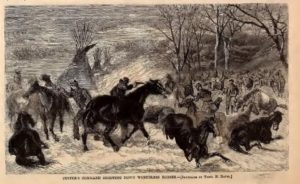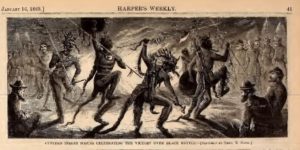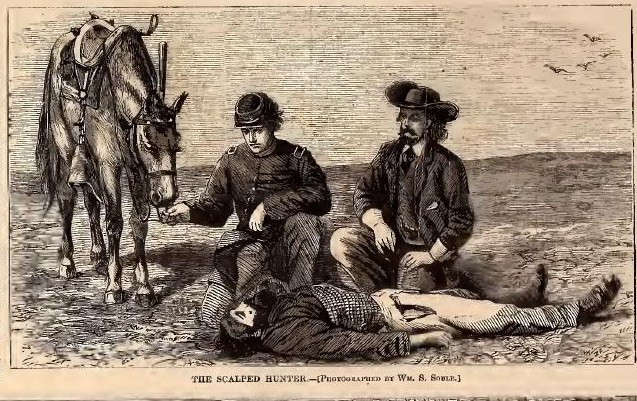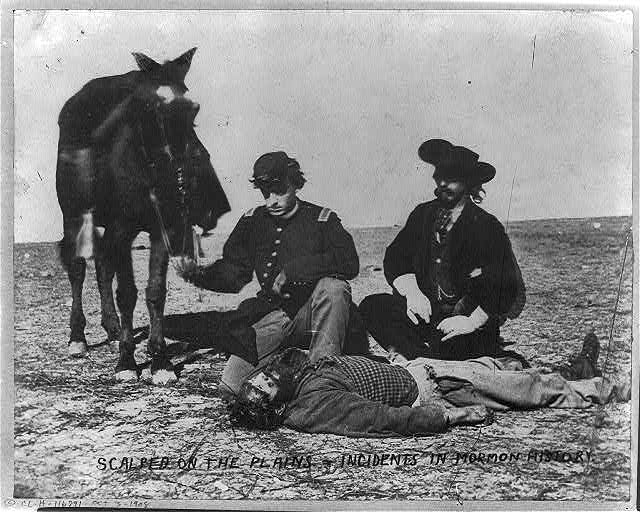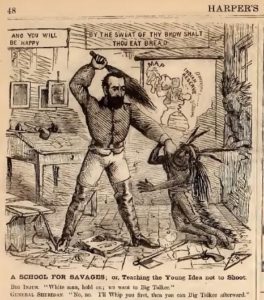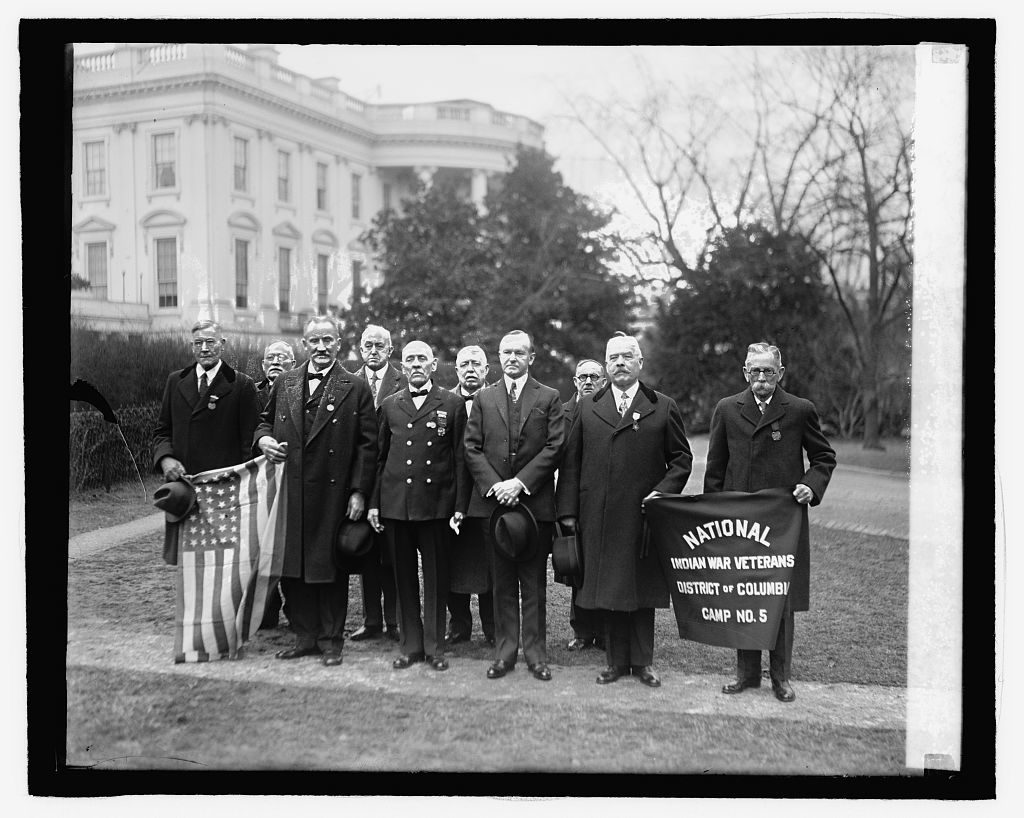From the January 16, 1869 issue of Harper’s Weekly (pages 41-42):
THE INDIAN WAR.
THE Indian Peace Commission of 1867 accomplished greater harm than benefit. Treaties were entered into with The Cheyennes, Arrapahoes, Kiowas, Comanches, and at the recommendation of the Commission the Powder River country was abandoned. This latter action was construed as the result of timidity on the part of the Government, and immediately the Sioux extended their depredations to the Pacific Railroad, on the Platte, while the Indians south of the Arkansas attempted to drive the whites out of the Smoky Hill country.
Last August the Cheyennes took the war-path, and the valleys of the Saline and Solomon rivers became the theatre of a relentless and savage war. It was at first supposed that the Cheyennes were about to attack a hostile tribe, but the soon the mask was laid aside, and in less than a month one hundred whites fell victims to the tomahawk and scalping-knife. The chiefs of the Arrapahoes had promised to proceed to Fort Cobb and get their annuities, and thence withdraw to their reservation. Instead of fulfilling their promises, they began a series of depredations on the line between Fort Wallace and Denver, in Colorado Territory. The Kiowas and Comanches about the same time entered into an agreement at Fort Zarah to remain at peace, and left with that impression fixed on the minds of those who represented the Government. The next information was that the Kiowas and Comanches had joined the Cheyennes and Arrapahoes. General SHERIDAN, taking the practical view of the condition of affairs within the limits of his department, at once transferred his head-quarters to the field, and commenced preparations for a determined war. General SULLY’S fight near this point, FORSYTH’S gallant fight on the Arrikaree fork of the Republican, CARPENTER’S and GRAHAM’S fight on the Beaver branch of the Republican, General CARR’S fight in the same vicinity, and General CUSTER’S annihilation of BLACK KETTLE’S band in the battle of the Washita, besides a number of small engagements, is the fighting record of three months. It would be a low estimate to say that at least 300 warriors have been killed since the war broke out. Two hundred and fifty are officially accounted for. The dexterity of the Indian in getting off his dead would largely increase the official count, which is based upon an accurate knowledge of the Indian loss from the bodies seen carried off, or which fell into the possession of the troops. Nor have the wounded been estimated; and it is quite natural to suppose that in a loss of two hundred and fifty warriors killed many more were wounded, of which a fair proportion may be called mortally, and subsequently died.
The desperation of the fighting at the battle of the Washita may be judged from the fact that no male prisoners over eight years of age were taken.
One of our illustrations on page 41 represents General CUSTER’S command shooting down the poor stock captured from BLACK KETTLE’S band. Another represents the Indian scouts of CUSTER’S command celebrating the victory over BLACK KETTLE. These scouts are Osages and Kaws. The celebration took place at night around a large wood-fire[?], encircled by officers and men who formed a ring comprising hundreds in number – the front rows sitting down or kneeling. The ceremonies were enlivened by music from the military bands. Inside the circle, by the Indian drummers, sat Generals SHERIDAN, CUSTER, and FORSYTH, and staff-officers. The Indians were highly painted, and adorned with shields, spears, war-bonnets, bows, whistles, and other “toggery.”
A third cut represents the body of RALPH MORRISON, killed and scalped by the Indians near Fort Dodge, Kansas. A correspondent from Fort Dodge sends us the following description:
Messrs. Editors:
The above is probably the only picture ever taken on the Plains of the body of a scalped man, photographed from the corpse itself, and within an hour after the deed was done.
The 7th December Mr. RALPH MORRISON, a hunter, was murdered and scalped by the Cheyenne Indians within less than a mile of this post. Mr. WILLIAM S. SOULE, chief clerk in Mr. JOHN E. TAPPAN’S trading establishment, an amateur artist, availed himself of the opportunity to benefit science and gratify the curiosity of your readers, by taking a counterfeit presentment of the body literally on the spot.
The pose of the remains is delineated exactly as left by the savages, the horrible contortion of the ghastly features, the apertures left by the deadly bullet, the reeking sculp, the wounds, the despoiled pockets of the victim, all are true to life, anomalous as the presentment of death may seem.
It is a satisfaction to know that the Indians suffered severely for their bloody act, two being killed by a percussion-shell from a Parrott gun belonging to the ordnance of Fort Dodge, served by admirable precision by Ordnance-sergeant HUGHES.
The Indians were promptly pursued, and two more of their saddles emptied by our scouts, whose chief, Mr. JOHN O. AUSTIN, is represented on the right of the picture. The officer is Lieutenant READE, Third Infantry. In this connection it may not be amiss to say that Mr. AUSTIN referred to, although unknown to Eastern journals, is one of the most experienced and daring scouts on the Plains. He bears upon his person many marks of his adventurous life. Years ago he was wounded in the head and face by arrows in an encounter with the Kiowas, fourteen miles west of the present site of Fort Dodge. October 5 (6?), next year, while scouting with Captain Newby [Newdy?], of the Mounted Rifle Corps, his right hand was literally cut in two by a tomahawk thrown by a wounded Arrapahoe chief. In April, 1859, his left arm was broken by an Apache Indian in a fight between Fort Craig and Selden, New Mexico. In the summer of 1860 the Cheyennes sent an arrow into his right knee near Bent’s Fort, Colorado Territory; and during the succeeding year a band of Texas desperadoes left him apparently dead after a bloody fight about sixty miles from Fort Garland, New Mexico.
All of these mishaps, however, did not prevent this hardy frontiersman from doing invaluable service for the Union during the late war, in the execution of which he was wounded in the back the evening before the battle of Chickamauga.
Such men are seldom met with, and when known deserve well of the country. A.B.C.
Later in the same issue of Harper’s a cartoon featured General Sheridan taking it to the Indians. In Three Years on the Plains: Observations of Indians, 1867-1870 (at Project Gutenberg) Edmund B. Tuttle dedicated his book to William T. Sherman and included an 1870 letter from the general that seemed to endorse a policy similar to that reflected in the cartoon:
LETTER FROM GENERAL SHERMAN
Headquarters, Army of the United States, Washington, D. C.,
June 13th, 1870.
Rev. E. B. Tuttle, Fort D. A. Russell, W. T.
Dear Sir,—I have your letter of June 8th, and do not, of course, object to your dedicating your volume on Indians to me. But please don’t take your facts from the newspapers, that make me out as favoring extermination.
I go as far as the farthest in favor of lavishing the kindness of our people and the bounty of the general government on those Indians who settle down to reservations and make the least effort to acquire new habits; but to those who will not settle down, who cling to their traditions and habits of hunting, of prowling along our long, thinly-settled frontiers, killing, scalping, mutilating, robbing, etc., the sooner they are made to feel the inevitable result the better for them and for us.
To those I would give what they ask, war, till they are satisfied.
Yours truly,
W. T. Sherman, General.

